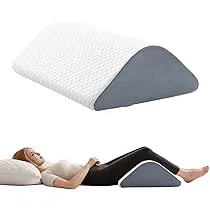The Ultimate Guide to Using a Knee Wedge Pillow for Spinal Decompression


If you're dealing with back pain, sciatica, or a herniated disc, you may have heard about spinal decompression therapy—a non-surgical treatment that helps relieve pressure on the spine and nerves. But did you know that something as simple as a knee wedge pillow can support this healing process? While it’s not a cure on its own, using a knee wedge pillow the right way can make a real difference in how your spine feels, especially when you're resting or sleeping.
This guide will walk you through everything you need to know about knee wedge pillows and how they can help people undergoing spinal decompression. We’ll explain how they work, the best way to use them, and why they’re a smart addition to your recovery plan—all in simple, easy-to-understand language.
A knee wedge pillow is a firm, triangular-shaped cushion designed to go under or between your knees when you're lying down. It’s not like a regular pillow—it’s built to hold its shape and provide steady support. These pillows are often made from memory foam, foam, or inflatable materials, and they come in different heights and firmness levels to match your comfort needs.
The main job of a knee wedge pillow is to support your legs and improve spinal alignment. When your knees are slightly raised, it changes the position of your pelvis and lower back, which can take pressure off your spine and help your body relax more deeply.
Spinal decompression is all about creating space between the bones in your spine so that the soft discs between them can rehydrate and heal. During the day, gravity and sitting for long hours press down on your spine, squeezing those discs. At night, when you lie down, your spine gets a chance to “un-squish” itself—but only if you’re in the right position.
A knee wedge pillow helps by:
Think of it like giving your spine a mini break every time you lie down. Over time, this can lead to less pain, better sleep, and faster recovery—especially when combined with other treatments like physical therapy or professional spinal decompression.
Using a knee wedge pillow is simple, but doing it right makes all the difference. Here’s how to get the most benefit:
The best position for using a knee wedge pillow is on your back. This keeps your spine straight and evenly supported. Place the pillow under both knees so your legs are gently raised.
Your knees should be bent at about a 30 to 45-degree angle—not too high, not too flat. This is the sweet spot for reducing pressure on the lower back. If the pillow is too tall, it might feel uncomfortable or strain your hips. If it’s too flat, it won’t help much.
A soft, saggy mattress can undo all the good work. Make sure you’re sleeping on a medium-firm surface that keeps your spine straight from head to hips. Memory foam or latex mattresses work well because they support your body’s shape without sinking too much.
If you’re new to using a wedge pillow, try it for 20–30 minutes at a time. Your body may need time to adjust. You can use it while resting during the day or while sleeping at night.
A knee wedge pillow works best when used with other healthy habits:
Knee wedge pillows are especially helpful for people with:
They’re also great for older adults, pregnant women, or anyone who spends long hours on their feet or in a chair. Even if you don’t have a diagnosed spine issue, using a wedge pillow can help prevent future problems by supporting healthy spinal alignment.
Not all wedge pillows are created equal. Here’s what to check before buying:
While knee wedge pillows are safe for most people, they’re not right for everyone. If you have:
…talk to your doctor before using one. In some cases, elevating the legs too much can cause discomfort or reduce blood flow.
Also, remember: a knee wedge pillow is a support tool, not a replacement for medical treatment. It works best when used alongside professional care like physical therapy, chiropractic adjustments, or spinal decompression therapy.
Many people notice a difference after just a few nights. They wake up with less stiffness, feel more relaxed during the day, and find it easier to stick to their recovery plan. Because better sleep leads to better healing, using a knee wedge pillow can be a small change with big results.
Some clinics even recommend them to patients after spinal decompression sessions to help maintain the benefits overnight. And since they’re affordable, portable, and easy to use, there’s little risk in giving one a try.
Can a knee wedge pillow help spinal decompression patients? Yes—when used correctly, it’s a simple, natural way to support your spine while you rest. It won’t fix everything on its own, but it can make a meaningful difference in your comfort, posture, and recovery speed.
If you’re looking for ways to relieve back pain, improve your sleep, or get the most out of your spinal treatment, a knee wedge pillow might be just what you need. Start with the right position, choose a quality pillow, and listen to your body. Over time, you may find that this small change leads to a much healthier, pain-free life.
To make an appointment with ReWin Therapy, simply click on the ‘Request an Appointment’ button below and follow the prompt. Alternatively, please call our reception during our operating hours.
